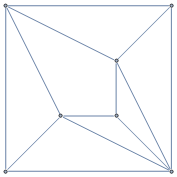Circle packing theorem states:
For every connected simple planar graph G there is a circle packing in the plane whose intersection graph is (isomorphic to) G.
How to use Mathematica to draw examples of such pairs (planar graph, circle packing)?
More specifically, the requirements of my question could be formulated as follows:
Generate a random connected simple planar graph with given number of nodes $N$ (this can be done lets say using adjacency matrix; in a way another parameter affecting resulting graph could be "density" of links). Draw its usual graphical representation containing nodes and links. Then draw its circle packing representation.
In other words, a solution could contain a slider for $N$, and a slider for the "density" (those two variables are parameters). Based on values of these sliders, get regular drawing of a random graph with given $N$ and density, and also drawing of its circle pack.
NOTE ON GENERATING RANDOM PLANAR GRAPHS:
To my knowledge, this is not a trivial problem, and there is no built-in Mathematica solution. Though, there are several questions and answers here. One of best is Create triangular mesh from random list of points :
SeedRandom[1];
pts = RandomReal[{0, 12}, {100, 2}];
Needs["ComputationalGeometry`"];
dt = DelaunayTriangulation[pts];
dt // Column
toPairs[{m_, ns_List}] := Map[{m, #} &, ns];
edges = Flatten[Map[toPairs, dt], 1];
Graphics[GraphicsComplex[pts, {Line[edges],
Red, PointSize[Large], Point[pts]}]]
NOTE ON GENERATING CIRCLE PACK CORRESPONDENT TO A PLANAR GRAPH:
See: Collins, Stephenson: A circle packing algorithm.
Visual examples:



This question is not an assignment. It is an intellectual experiment, related to aestetics and structure. I am not requesting code. I am seeking ideas, approaches, and solutions.




